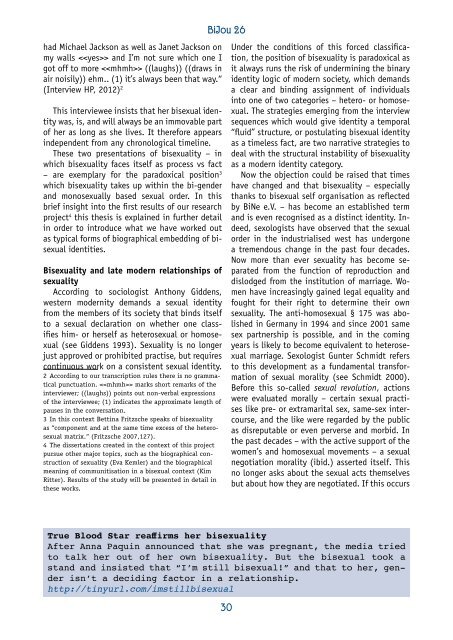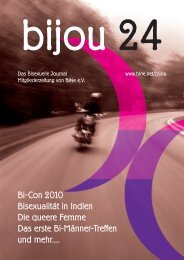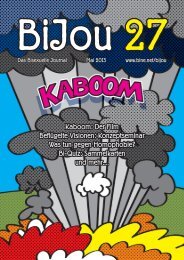BiJou 26 - BiNe Bisexuelles Netzwerk eV
BiJou 26 - BiNe Bisexuelles Netzwerk eV
BiJou 26 - BiNe Bisexuelles Netzwerk eV
You also want an ePaper? Increase the reach of your titles
YUMPU automatically turns print PDFs into web optimized ePapers that Google loves.
had Michael Jackson as well as Janet Jackson on<br />
my walls and I’m not sure which one I<br />
got off to more ((laughs)) ((draws in<br />
air noisily)) ehm.. (1) it’s always been that way.“<br />
(Interview HP, 2012) 2<br />
This interviewee insists that her bisexual identity<br />
was, is, and will always be an immovable part<br />
of her as long as she lives. It therefore appears<br />
independent from any chronological timeline.<br />
These two presentations of bisexuality – in<br />
which bisexuality faces itself as process vs fact<br />
– are exemplary for the paradoxical position 3<br />
which bisexuality takes up within the bi-gender<br />
and monosexually based sexual order. In this<br />
brief insight into the first results of our research<br />
project 4 this thesis is explained in further detail<br />
in order to introduce what we have worked out<br />
as typical forms of biographical embedding of bisexual<br />
identities.<br />
Bisexuality and late modern relationships of<br />
sexuality<br />
According to sociologist Anthony Giddens,<br />
western modernity demands a sexual identity<br />
from the members of its society that binds itself<br />
to a sexual declaration on whether one classifies<br />
him- or herself as heterosexual or homosexual<br />
(see Giddens 1993). Sexuality is no longer<br />
just approved or prohibited practise, but requires<br />
continuous work on a consistent sexual identity.<br />
2 According to our transcription rules there is no grammatical<br />
punctuation. marks short remarks of the<br />
interviewer; ((laughs)) points out non-verbal expressions<br />
of the interviewee; (1) indicates the approximate length of<br />
pauses in the conversation.<br />
3 In this context Bettina Fritzsche speaks of bisexuality<br />
as “component and at the same time excess of the heterosexual<br />
matrix.“ (Fritzsche 2007,127).<br />
4 The dissertations created in the context of this project<br />
pursue other major topics, such as the biographical construction<br />
of sexuality (Eva Kemler) and the biographical<br />
meaning of communitisation in a bisexual context (Kim<br />
Ritter). Results of the study will be presented in detail in<br />
these works.<br />
<strong>BiJou</strong> <strong>26</strong><br />
True Blood Star reaffirms her bisexuality<br />
After Anna Paquin announced that she was pregnant, the media tried<br />
to talk her out of her own bisexuality. But the bisexual took a<br />
stand and insisted that “I’m still bisexual!” and that to her, gender<br />
isn’t a deciding factor in a relationship.<br />
http://tinyurl.com/imstillbisexual<br />
30<br />
Under the conditions of this forced classification,<br />
the position of bisexuality is paradoxical as<br />
it always runs the risk of undermining the binary<br />
identity logic of modern society, which demands<br />
a clear and binding assignment of individuals<br />
into one of two categories – hetero- or homosexual.<br />
The strategies emerging from the interview<br />
sequences which would give identity a temporal<br />
“fluid” structure, or postulating bisexual identity<br />
as a timeless fact, are two narrative strategies to<br />
deal with the structural instability of bisexuality<br />
as a modern identity category.<br />
Now the objection could be raised that times<br />
have changed and that bisexuality – especially<br />
thanks to bisexual self organisation as reflected<br />
by <strong>BiNe</strong> e.V. – has become an established term<br />
and is even recognised as a distinct identity. Indeed,<br />
sexologists have observed that the sexual<br />
order in the industrialised west has undergone<br />
a tremendous change in the past four decades.<br />
Now more than ever sexuality has become separated<br />
from the function of reproduction and<br />
dislodged from the institution of marriage. Women<br />
have increasingly gained legal equality and<br />
fought for their right to determine their own<br />
sexuality. The anti-homosexual § 175 was abolished<br />
in Germany in 1994 and since 2001 same<br />
sex partnership is possible, and in the coming<br />
years is likely to become equivalent to heterosexual<br />
marriage. Sexologist Gunter Schmidt refers<br />
to this development as a fundamental transformation<br />
of sexual morality (see Schmidt 2000).<br />
Before this so-called sexual revolution, actions<br />
were evaluated morally – certain sexual practises<br />
like pre- or extramarital sex, same-sex intercourse,<br />
and the like were regarded by the public<br />
as disreputable or even perverse and morbid. In<br />
the past decades – with the active support of the<br />
women’s and homosexual movements – a sexual<br />
negotiation morality (ibid.) asserted itself. This<br />
no longer asks about the sexual acts themselves<br />
but about how they are negotiated. If this occurs<br />
in a process in which all parties have consented,<br />
the sexual act is generally regarded as morally<br />
legitimate. These starting condi-tions could be a<br />
good basis for questioning the institutionalised<br />
heterosexuality of society and thus the meaning<br />
of hetero-, homo-, and bisexuality as hierarchically<br />
ordered categories. Or at least that’s what<br />
other sexologists such as Volkmar Sigusch suspect.<br />
He counts forms of bisexuality among the<br />
neosexualities that arise under these “freed up”<br />
conditions (see: Sigusch 2011) in which sexual<br />
practises and identities have become more flexible<br />
and de-tach themselves from heteronormative<br />
patterns.<br />
Doubts may arise at the conceptualisation of<br />
bisexuality as an alleged neosexuality. Historically,<br />
the “invention” of bisexuality as a social<br />
identity category falls in together with the modern<br />
development of the homo- and heterosexual<br />
categories (see: Haeberle 1994) – a pro-cess<br />
that Michel Foucault refers to as the incarnation<br />
of perversion (Foucault 1983, 47). So bisexuality<br />
as a category in western modernity isn’t exactly<br />
something new. In addition, there are some good<br />
arguments against the adaptation of a comprehensive<br />
revolution of sexual order, which would<br />
release bisexuality from its paradoxical position.<br />
Naturalised bi-gender monosexuality can – albeit<br />
under different conditions – still be referred to<br />
as a cornerstone of sexual order (Jackson/Scott<br />
2010; Seidmann 2009). In one of his empirical<br />
studies, Gunter Schmidt, too, only sees a minimal<br />
brittleness of monosexual order in younger<br />
generations (Schmidt et. al 2006, 132). Under<br />
these conditions bisexuality retains its structural<br />
instability and its character as a “threat” to<br />
monosexual order. This is evident in the ongoing<br />
hostility towards bisexuality – often also in relation<br />
to homosexuality. In his work, Christian<br />
Klesse refers to this hostility as biphobia (see:<br />
Klesse 2007). It’s embodied in a general allegation<br />
of promiscuity, devaluation of any nonmonogamous<br />
lifestyle, an oversexualisation of<br />
bisexual lifestyles, and the claim of immaturity,<br />
irresponsibility, and inability to be part of a<br />
“real” relationship. Despite the changes in how<br />
society views sexuality, the question remains<br />
how our interviewees manage to embrace bisexuality<br />
in their life stories under the conditions<br />
of such a bi-gender monosexual society.<br />
<strong>BiJou</strong> <strong>26</strong><br />
31<br />
About the study<br />
Our approach easily translates to Garber’s<br />
thoughts of determining bisexuality as a narrative.<br />
By conducting the biographical interviews<br />
we didn’t want to point out statistical categories<br />
but simply deal with the life stories of our<br />
interviewees, which have come about through a<br />
mixture of social order, life experiences, the memory<br />
of these experiences and the interac-tions<br />
taking place during the interview (Rosenthal<br />
1995). The size of the sampling (31 inter-views)<br />
clearly shows that we are not entitled to do a<br />
representative study. The strength in our approach<br />
lies more in a closer look at the incorporation<br />
of bisexuality in life stories, which reveals<br />
processes which statistics do not consider (no<br />
matter how desirable it might be since there’s a<br />
big gap in the field of quantitative research as<br />
well). Therefore, the statements that we make<br />
should not be understood as generalised statements<br />
about bisexuals, but instead as detailed<br />
reconstructions of current forms of biographical<br />
construction of bisexuality in German society.<br />
Biographical construction of bisexual identities<br />
In dealing with bisexuality, one should distinguish<br />
between bisexual desire, bisexual practise,<br />
and bisexual identity. Bisexual practise doesn’t<br />
necessary follow bisexual identity or vice versa.<br />
If bisexuality is understood as an identity – as<br />
a part of one’s self – then a certain biographical<br />
work is required to harmoniously insert the bisexuality<br />
into the life story. Looking at this biographical<br />
construction of bisexual identity and at<br />
the results of our research so far, the embedding<br />
of bisexuality as process or fact can be schematically<br />
differentiated. These typical constructions<br />
also carry with them the opening of certain resources,<br />
but also problems and challenges our<br />
biographers 5 might have to face.<br />
The processual embedding of bisexual identity<br />
is exemplified in the above-cited case in which a<br />
bisexual woman actually forgot her first coming<br />
out. The meaning of bisexual identity in these<br />
cases has a highly temporal structure meaning<br />
that its relevance evolves depending on each<br />
biographical situation. A resource for dealing<br />
with this is the possibility of flexible adaptati-<br />
5 We make use of the term biographers instead of autobiographers<br />
to make clear that every biography is shaped by<br />
society.
















